| 1 | The most northerly-dwelling boa |
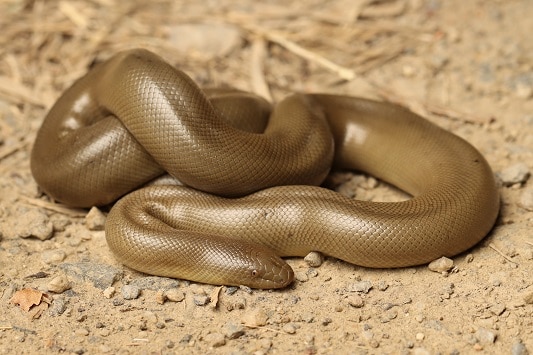
Boas are normally associated with dense, green rainforests in pictures, but there’s one that inhabits the muddy woodlands of Washington state, or even Canada. This is the rubber boa (Charina bottae), the most northerly dwelling boa in the world.
Rubber boas are extremely well adapted to cold weather, and can inhabit a wide variety of temperate habitats. Their potential homes include deciduous forests, grassland, chaparral, villages and desert sagebrush. Their only consistent requirement is cool temperatures, and cover to hide beneath, as this is a shy snake. Rubber boas are commonly found beneath rotting logs, bushes and forest mulch, but also urban objects like cardboard or plywood.
According to a study from British Columbia, rubber boas spend 25% of their day hiding under cover, and the rest underground. This is a fairly social snake species, huddling together under plywood for warmth. 7 can rest together peacefully at once, sometimes with a garter snake buddy as well. When a group of boas separated from the pack millions of years ago, and headed northwards, they had no clue of the frosty route evolution would take them on.
| 2 | Super docile and peaceful |
While flexible, rubber boas do have a top habitat: forest clearings with a mixture of rock and grass. Their range extends southwards to California, but the warmer the climate, the more mountainous the areas they inhabit.
If you meet one, then survival is assured, as the rubber boa is one of the least aggressive snakes in the United States. There isn’t a single recorded bite, and you can hold one in the palm of your hand for an hour with no savage explosion of aggression. They only have two defensive tricks. The first is coiling themselves into a ball, extending their thick tail, and whacking it down against the aggressor. But unlike the sharp-tailed snake, their tails are soft and harmless. The other trick is squirting a foul-smelling liquid towards the curious human.
This species has a long history, as certain Native American tribes wore amulets made from the rubber boa’s tail. Another claim to fame is being one of the world’s smallest boas. They reach a maximum of 85cm, and most are 40-60cm as adults. Newborns measure just 18-28cm, and are as thin as a pencil.
| 3 | Their rubbery appearance |
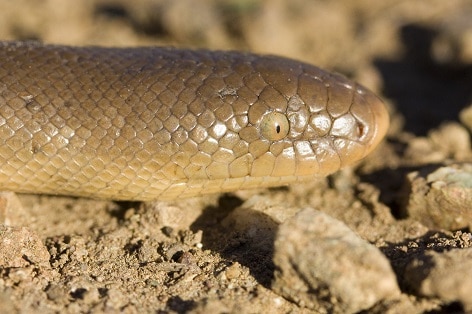
Rubber boas are also known for their loose, crinkled skin, which you can particularly witness when they curl into a ball. This combines with their extremely smooth scales, and suddenly, you have a boa which looks like it’s made from rubber.
Rubber boas are typically a bronze colour, with a lighter belly, but can be dark brown or have yellow tinges. They have vertical pupils, like most nocturnal snakes, and become duller with age. Newborns can even be bright pink or yellow. As adults, they have virtually no patterns, and are thought to be a particularly primitive boa, closely related to old world sand boas (Eryx family) like the Arabian sand boa.
Rubber boas don’t have a rainbow explosion of colour morphs like the eyelash viper, but weird ones have been spotted. These include rubber boas with fully black eyes, or eyes with a flame-like orange bordered by green. A rubber boa’s eyes are weird at the best of times, so tiny that they look like a single enlarged scale.
| 4 | Confuses enemies with its tail |
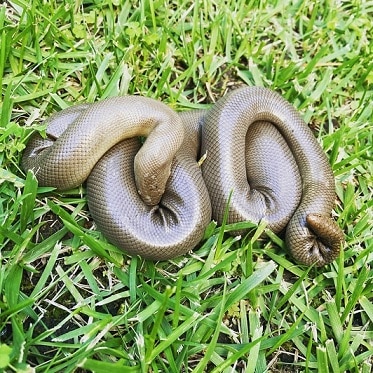
One of a rubber boa’s special survival features is its tail. Its body tapers and thins right on schedule, until the very tip, where it suddenly gets thicker again. Rubber boas have a tail which is enlarged to match their head, which they move rhythmically to lure predators away from their brains. When threatened, they coil up, and stash their head in the centre, keeping their neurons shielded.
Wild rubber boas commonly have scars and nicks on their tail. Sometimes, they’ve had so many battles that bone tips are showing. This tail distraction is one reason, but another is their diet of deer mice. They have a tendency to invade burrows and gobble up a sleeping mammal family at night, in their cosy underground chambers. Mothers often rush to defend their babies, and in response, the rubber boa sweeps its thick tail around to club them aside.
But they often get more than they’re bargaining for, as the furious mother mouse bites and claws the tip. Some believe that this is another head lure, tricking the mother into attacking the tail, accepting the price of bites that they pay.
| 5 | The snowiest snake? |
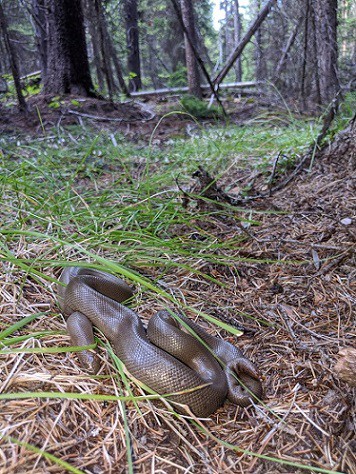
Rubber boas have extreme cold tolerance. They’ve been spotted before slithering along snow, and attempting to burrow into it, and basking in a faint winter sun at temperatures just above freezing. Males have been spotted on slopes in Utah just 2 days after a February snowstorm, resting in the sun, with one touching a patch of snow.
Wild rubber boas can have a body temperature as low as 54F (12.2C) without deactivating, with the most extreme record being 44F. To aid in their frosty quest, they have the power to concentrate bodily heat reserves in their head, preserving the brain.
But they also have weaknesses, such as an intolerance to dry conditions, as their skin is more permeable to moisture than most snakes. This is why they lurk in the damp underground. Likewise, they’re poorer at tolerating heat. Reptile keepers recommend keeping cages at just 70-85 fahrenheit – the 95 degrees of Amazon rainforest snakes can prove fatal.
| 6 | Tiny home territories |
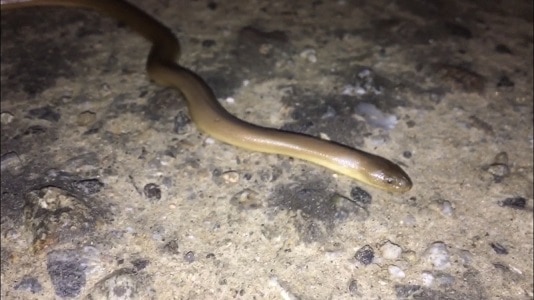
Rubber boas have one of the tiniest home territories of any snake. Individual boas are spotted in the same forest clearing year after year, coming out to warm their bodies in the sun occasionally. In one study, the largest home range of an individual rubber boa was just 64 metres. This is a sluggish snake which moves very slowly. This makes escaping from birds difficult, and consequently, rubber boas have evolved to be nocturnal, with their retina adapted to contain less rods and more cones.
The only thing that springs a rubber boa into life is the late autumn dash to their hibernacula. Rubber boas hibernate in the exact same spot each year, whether it be rock crevices or mammal burrows, or manmade spots like old wells, cisterns and building foundations. They can travel 1.5 kilometres to return to their faithful spot.
Like common garter snakes, choosing the correct hibernation site is a life or death situation in the frigid Canadian winter. One mistake, and freezing is unavoidable. South-facing rocky slopes are a top hibernation spot for rubber boas, as these absorb extra sunlight.
| 7 | Diet: deermice and voles |
Rubber boas are primarily mammal eaters, which raid the dens of nesting mice and voles. These boas can be oddly specific, as they often reject the simple house mouse in captivity, the pinkies which most snakes thrive on. When offered, they didn’t budge; they refused to fleck their tongue inquisitively or move their jaws, as though they didn’t recognise them as food. Only with baiting and fake scenting did they grow adapted to the pinkies.
It’s thought that deer mice are their primary prey in the wild. In Nevada County, California, a rubber boa was found in a fallen pine tree, after which it regurgitated two montane voles.
That said, rubber boas are flexible and can also eat alligator lizards. Many disturbing stories have come to light. Rubber boas are occasionally a snake-eating snake, with one confirmed prey being the terrestrial garter snake (Thamnophis elegans). One time, two rubber boas, an adult male and a juvenile, began swallowing the same mouse. They came at the mouse from different sides, covering more and more ground, until their lips met in the middle. They paused, until the adult rubber boa made a decision and kept on swallowing forward. The outraged younger boa instantly coiled its lower body around the adult, attempting to free itself. After a valiant struggle, the young rubber boa managed to escape.
| 8 | Eats its prey slowly |
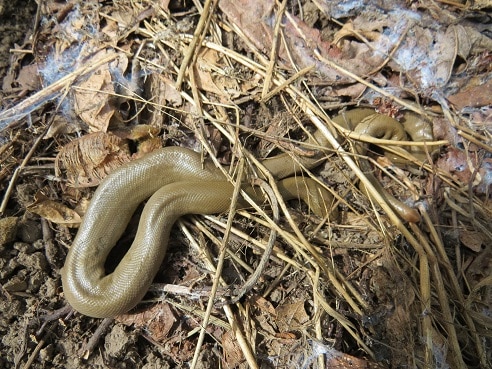
Rubber boas make for great pets, but watch out! Rubber boas are skilful escape artists, identifying weaknesses in cages and slithering through to freedom. Keepers also testify that keeping sand or fine dirt in a rubber boa’s cage is a big mistake. They inhale the tiny particles, leading to clogged sinuses and ultimately infections. Pine and aspen shavings work well.
A captive rubber boa should never be constantly on the move in their enclosure, as this is a sign of unhappiness. Their behaviour should mirror their wild lifestyle – resting comfortably under a rotting log, bush, or other random object.
Boas aren’t averse to sudden, savage lunges to acquire their prey. Both boa constrictors and emerald tree boas strike from a tree branch, having previously been still as a statue. But rubber boas prefer to take their time, gently sniffing and analysing a mouse before finally making the carefully considered decision to swallow. Supposedly, the rubber boa is so calm that holding them can wipe out people’s fear of snakes altogether.
| 9 | Goes 2 years without eating |
Because of their frosty ways, and belonging to the slow, patient boa family, rubber boas can go an extremely long time without eating. The colder a snake’s environment, the more its metabolism will decelerate.
One captive keeper kept a female rubber boa which refused to eat for 2 years. He decided not to force feed the snake, and while she gradually lost weight, she kept a healthy muscle tone and plentiful fat reserves. Eventually, she randomly decided to start eating again. Likewise, baby rubber boas (which come in batches of 2-8) are born in late August or early September, and won’t eat until the following spring.
Occasionally, they even stay in their hibernacula for an entire year through to their second winter, and don’t eat for the first 18 months of their lives. Even adult males refuse to eat until late spring in any given year, usually reawakening the desire for mice in June. Spring is breeding season, and they have other things on their mind.
| 10 | Lives to 65 years? |
Rubber boas are an extremely long-lived snake, particularly for such a small species. Exceeding 20 years is nothing noteworthy whatsoever. One of the oldest was a female called Raab 1, who was first spotted by Richard Hoyer in 1971. The location was near Corvallis in Oregon, and the boa had scars and gashes on her tail from a recent duel. She was 27.5 inches (69.85cm) long, and estimated at 20 years old or more already.
In 1975, Hoyer located her again, and by now the injured tail had a slight white spot of bone protruding. He continued to find her over the next 8 years, until 1983, when Hoyer casually told the local kids about the rubber boas he was researching. From that day on, the local snakes mysteriously started dying. Alarmed, Hoyer moved Raab 1 to a new site 10 miles north, Camp Adair. She was grinding on with her life the same as ever, now estimated at 30 plus years old.
By 1989 though, she had several injuries on her body, and was taken into captivity permanently. Little did Hoyer realise that she would survive for another 17 years. On a steady diet of Townsend’s voles, deer mice, and grey-tailed voles, Raab 1 just continued on and on. In 2006, she finally stopped eating, no matter how much persuasion was given, and several months later she died. It was 35 years after her initial discovery, and she may have been over 65 years old. In 2000, she even gave birth to a litter of 4 young. Her body was sent to a natural history museum for scientific preservation.
